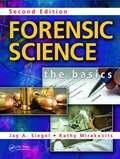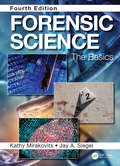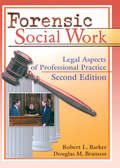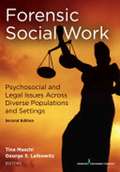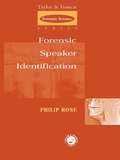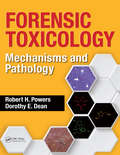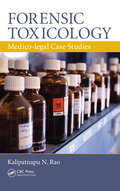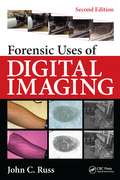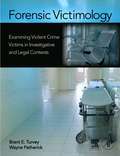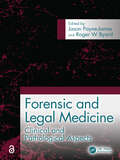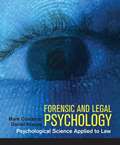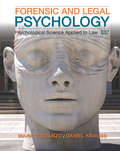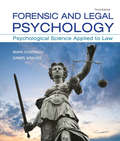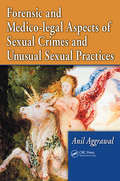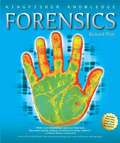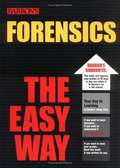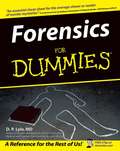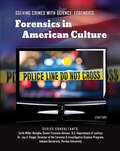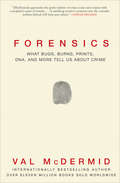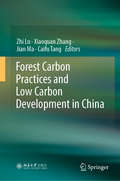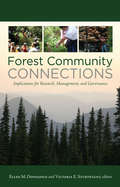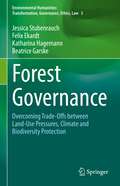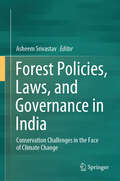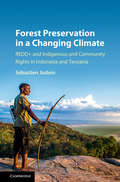- Table View
- List View
Forensic Science: The Basics (2nd Edition)
by Jay A. Siegel Kathy MirakovitsForensic Science: The Basics takes students through the criminal justice and forensic science systems from crime scene to court. It builds a solid foundation of tools such as microscopy, spectroscopy, and separation sciences and then applies them to the analysis of both the familiar types of evidence such as DNA, drugs, and trace evidence, but still covers the not so commonly studied "-ologies"--pathology, anthropology, odontology, and entomology.
Forensic Science: The Basics, Fourth Edition
by Kathy Mirakovits Jay A SiegelForensic Science: The Basics, Fourth Edition is fully updated, building on the popularity of the prior editions. The book provides a fundamental background in forensic science, criminal investigation and court testimony. It describes how various forms of evidence are collected, preserved and analyzed scientifically, and then presented in court based on the analysis of the forensic expert. The book addresses knowledge of the natural and physical sciences, including biology and chemistry, while introducing readers to the application of science to the justice system. New topics added to this edition include coverage of the formation and work of the NIST Organization of Scientific Area Committees (OSACs), new sections on forensic palynology (pollen), forensic taphonomy, the opioid crisis, forensic genetics and genealogy, recent COVID-19 fraud schemes perpetrated by cybercriminals, and a wholly new chapter on forensic psychology. Each chapter presents a set of learning objectives, a mini glossary, and acronyms. While chapter topics and coverage flow logically, each chapter can stand on its own, allowing for continuous or selected classroom reading and study. Forensic Science, Fourth Edition is an ideal introductory textbook to present forensic science principles and practices to students, including those with a basic science background without requiring prior forensic science coursework.
Forensic Social Work: Legal Aspects of Professional Practice, Second Edition
by Robert L. Barker Douglas M. BransonExplore the legalities and pitfalls of forensic social work!Forensic Social Work: Legal Aspects of Professional Practice, Second Edition examines the professional specialty of forensic social work which involves testifying in court as an expert witness, investigating cases of possible criminal conduct, and assisting the legal system in such issues as child custody disputes, divorce, child support, juvenile delinquency, spouse or child abuse, and placing individuals in mental hospitals. As a student or professional social worker, you will explore a variety of ethical and legal issues, such as malpractice, licensing, credentialing, marketing for forensic clients, and presenting effective courtroom testimony. Current and fact-filled, this new edition discusses the origins of forensic social work and offers implications for future practice.New material in this edition includes a chapter on how to establish a forensic social work practice, with information on how to bring in clients, generate new referrals and make other important contacts. Another new chapter expands on the first edition's discussion of implanted memory versus recovered memory and the ways that social workers use and often misuse this information. A third new chapter examines credentialing requirements for forensic social work. Forensic Social Work details legal conflicts you may face and offers suggestions on how to deal with these situations. Rich with examples, some aspects of forensic social work that you will learn about are: separating the role of the expert witness from the role of the fact witness while testifying understanding the motivations, payments, and positive incentives for entering the field of forensic social work avoiding malpractice lawsuits by understanding the criteria for liability guidelines for action when laws and ethics collide preparing for litigation duty-to-warn laws writing reports and contracts for the litigious society using the problem-oriented (SOAP) record distinguishing implanted memory from recovered memory and understanding how witnesses and social workersmay misuse remembered informationComplete with a glossary, case examples, and information on how to obtain clients, new referrals, and other contacts, Forensic Social Work gives you a thorough look at the profession of forensic social work. You will explore the legal and ethical issues that come with this profession, learn the credentials needed to become a forensic social worker, and discover how to adequately market yourself in the field. Forensic Social Work will prepare you for the circumstances that may arise and help you to professionally and successfully overcome future challenges.
Forensic Social Work: Psychosocial And Legal Issues Across Diverse Populations And Settings
by Tina Maschi George Stuart LeibowitzThis extensively revised edition reviews the latest research and practices in forensic social work. Readers learn to integrate socio-legal knowledge when working with diverse populations in a variety of settings. Noted interdisciplinary contributors review the most common forensic issues encountered in the field to better prepare readers to deal with the resulting financial, psychological, emotional, and legal ramifications. Using a human rights and social justice approach, the book demonstrates the use of a forensic lens when working with individuals, families, organizations, and communities that struggle with social justice issues. Each chapter features objectives, competencies, Voices From the Field, a conclusion, exercises, and additional resources.
Forensic Speaker Identification
by Phil RoseA voice is much more than just a string of words. Voices, unlike fingerprints, are inherently complex. They signal a great deal of information in addition to the intended message: the speakers' sex, for example, or their emotional state, or age. Although evidence from DNA analysis grabs the headlines, DNA can't talk. It can't be recorded planning,
Forensic Toxicology: Mechanisms and Pathology
by Robert H. Powers Dorothy E. DeanDesigned for graduate and advanced undergraduate courses, this book goes beyond the simple analysis of naming a drug or toxin, taking a mechanistic approach to their effects on the body. It provides an understanding of the mechanisms of action of drugs and toxins as well as their physiologic and pathologic consequences on the affected organ system. Case histories, photographs of gross pathology, and photomicrographs further illustrate the processes and effects of toxic substances on the body.
Forensic Toxicology: Medico-Legal Case Studies
by Kalipatnapu N. RaoModern technology using state-of-the-art equipment can now identify almost any toxin relevant to a legal issue. Techniques include gas chromatography, mass spectrometry, high-pressure liquid chromatography, and the combination of these methods. Forensic Toxicology: Medico-legal Case Studies demonstrates how the science of forensic toxicology acts a
Forensic Uses of Digital Imaging
by John C. Russ Jens Rindel P. LordThe ability to work with, and retrieve images, is vital to forensic and criminal case work. During a five-decade-long career, author John C. Russ has taught methods for image processing and measurement to thousands of students. Forensic Uses of Digital Imaging, Second Edition distills his classroom and workshop material to present the information m
Forensic Victimology: Examining Violent Crime Victims in Investigative and Legal Contexts
by Brent E. Turvey Wayne PetherickThis new textbook provides students with the basic principles and practice standards of forensic victimology -the scientific study of victims for the purposes of addressing investigative and forensic issues. It provides case-based coverage with original insights into the role that victimology plays in the justice system, moving beyond the traditional theoretical approaches already available. The purpose of this textbook is to distinguish the investigative and forensic aspects of victim study as a necessary adjunct to the field of victimology. It identifies forensic victimologists in the investigative and forensic communities and provides them with methods and standards of practice needed to be of service. This book is intended to educate students on the means and rationale for performing victimological assessments with a scientific mindset. Forensic Victimology is designed specifically for teaching the practical aspects of this topic, with "hands on" real-life case examples and an extensive online Instructor's manual featuring summaries, key terms, and test questions for every chapter. * Applied victimology for students and caseworkers performing objective examinations as opposed to theoretical victimology that studies victim groups and crime statistics. * First ever textbook detailing a mandate, scope and methods for forensic victimologist practitioners. * Provides a critical / scientific counterbalance to existing mainstream texts approaching general victimology with a pro-victim bias. * Written by practitioners of forensic victimology in the investigative, forensic, mental health, and academic communities.
Forensic and Legal Medicine: Clinical and Pathological Aspects
by Jason Payne-James Roger ByardA comprehensive and accessible resource covering all aspects of forensic and legal medicine. The text provides a foundation for those working in both the clinical and forensic aspects of care and will also be an asset to those involved in the police or judicial systems. Including clear guidelines for practical applications, and further enhanced by its many illustrations and case examples, this text is a valuable resource in an increasingly complex field. The authoritative work is written by those who have extensive experience for a wide audience including, but not limited to, forensic pathologists, general pathologists, pediatric pathologists, forensic physicians, forensic scientists, coroners, emergency department physicians, judges and legal practitioners. Chapter 62 of this book is freely available as a downloadable Open Access PDF at http://www.taylorfrancis.com under a Creative Commons [Attribution-Non Commercial-No Derivatives (CC-BY-NC-ND)] 4.0 license.
Forensic and Legal Psychology
by Mark Costanzo Daniel KraussUsing research in clinical, cognitive, developmental, and social psychology,Forensic and Legal Psychologyshows how psychological science can enhance the gathering and presentation of evidence, improve legal decision-making, prevent crime, rehabilitate criminals, and promote justice. Although the emphasis is on psychological research, the textbook makes extensive use of actual cases and real trials to engage students and to illustrate the relevance of research findings. Written in a clear, student-friendly style,Forensic and Legal Psychologyis designed for both the psychology and law AND forensic psychology class. Visit the preview site for more information:www. worthpublishers. com/costanzokrausspreview
Forensic and Legal Psychology
by Mark Costanzo Daniel KraussDrawing on a combined three decades of teaching experience, Costanzo and Krauss help students explore the fascinating intersections where psychology and the law meet, in an excitingly written textbook that presents the latest research in the context of dozens of real cases. As before, the new edition draws on extensive research in social, cognitive, clinical, and developmental psychology to explore virtually every aspect of the legal system studied by psychologists, emphasizing the ways research and theory deepen our understanding of key participants (e. g. , criminals, police, victims, lawyers, witnesses, judges, and jurors) and basic psychological processes (e. g. , decision-making, persuasion, perception, memory, and behavior change).
Forensic and Legal Psychology: Psychological Science Applied to Law
by Mark Costanzo Daniel KraussCostanzo and Krauss show students how psychological science can be used to enhance the gathering of evidence, improve legal decision making, reduce crime, and promote justice. With the integration of fascinating real trials, cases and other examples of the legal system in action, the authors illustrate how research and theory can deepen our understanding of suspects, criminals, police officers, victims, lawyers, witnesses, judges, and jurors. Costanzo and Krauss accessibly illustrate the relevance of key research findings in social, cognitive, clinical, and developmental psychology to virtually every aspect of the legal system psychologists have studied
Forensic and Medico-legal Aspects of Sexual Crimes and Unusual Sexual Practices
by Anil AggrawalFrom sexual abuse and fetishism to necrophilia and sadomasochism, this unique volume identifies fourteen classifications of unusual sexual pathologies. Emphasizing the physical and psychological aspects of sexuality itself, the book presents detailed comparisons of legal and medical definitions, historical aspects, current incidence, and geographic
Forensics
by Richard PlattExplore the crime lab with Forensics and discover how detectives use science to solve crimes. From the scene of the crime to a criminal's conviction, discover how the marks of blood, footprints, and fingerprints can lead the police to criminals. Find out how specialists can match trace evidence, such as a single hair found on a victim, to the murderer. Learn how famous crimes were solved and, like a true detective, find out whether it was arson, poison, or murder.
Forensics The Easy Way
by Harold H. TrimmThe science of forensics and the crime investigation lab have become an increasingly important aspect of police work. This brand-new Easy Way title introduces criminology students and law enforcement candidates to forensics in four major sections: Introduction to Forensic Science, The Physical Sciences, Physical Evidence, and The Future of Forensic Science. Among the topics explored are applications of the sciences of physics and chemistry to forensics, physical evidence, body fluids, explosives and incendiaries, firearms, fingerprints, DNA evidence, and many more. Discussion of future trends includes retinal scans and other ID systems, computer databases and searches, and more. Review questions with answers appear at the end of each chapter. Barron's Easy Way books introduce a variety of academic and practical subjects to students and general readers in clear, understandable language. Ideal as self-teaching manuals for readers interested in learning a new career-related skill, these books have also found widespread classroom use as supplementary texts and brush-up test-preparation guides. Subject heads and key phrases that need to be learned are set in a second color.
Forensics for Dummies
by D. P. LyleForensics for Dummies is an introduction to the field of forensic science, covering a broad range of forensic topics in a clear and concise fashion. It includes many examples of how these techniques are applied in real-life situations. Case studies are included throughout the book to illustrate how forensic science was used to solve famous cases. This book is an excellent starting point for fresher and for those familiar with many forensic topics, it serves to refresh and expand the knowledge.
Forensics for Kids: The Science and History of Crime Solving, With 21 Activities (For Kids series)
by Melissa RossWhat kind of science does it take to solve a crime? Forensics for Kids provides the complete history of forensic science, giving readers a comprehensive understanding of crime-solving development and the birth of modern forensics. Author Melissa Ross uncovers fascinating stories, famous cases, pioneers who led the way, and what forensics might look like in the future. Twenty-one engaging activities offer readers experiential learning of the science and history of forensics. Kids have the opportunity to hear from experts in the field, explore forensic labs and tools, and delve into subjects such Hitler's forged diaries and the mystery of General Jackson's arm. Kids can become the next real-life Sherlock Holmes or Nancy Drew after exploring the science of forensics.
Forensics in American Culture: Obsessed With Crime (Solving Crimes With Science: Forensics)
by Jean FordWhy are programs such as CSI, Law & Order, and Cold Case so popular? Because our culture is fascinated with crime--and these television shows reveal investigators' procedures and secrets. With so many forensic-based television programs, it might seem that North America's morbid curiosity is a new phenomenon. The truth is, however, that humanity have always been fascinated by that which also frightens them. What's more, humans are attracted to puzzles--and forensic science offers opportunities to solve mysteries while at the same time "catching the bad guys." Modern media has only magnified the tendencies of previous generations. This book takes a look at the ways this fascination with crime shapes modern news media, television programming, movies, and the Internet. It also provides information on the real-life opportunities for forensic careers. Forensic science is more than just a cultural obsession--it's a fast-growing professional field. Forensics in American Culture will reveal this field's intriguing mixture of science, mystery, excitement, and justice.
Forensics: What Bugs, Burns, Prints, DNA, and More Tell Us About Crime
by Val McDermidVal McDermid is one of the finest crime writers we have, whose novels have captivated millions of readers worldwide with their riveting narratives of characters who solve complex crimes and confront unimaginable evil. In the course of researching her bestselling novels McDermid has become familiar with every branch of forensics, and now she uncovers the history of this science, real-world murders and the people who must solve them. The dead talk to the right listener. They can tell us all about themselves: where they came from, how they lived, how they died, and, of course, who killed them. Forensic scientists can unlock the mysteries of the past and help serve justice using the messages left by a corpse, a crime scene, or the faintest of human traces. Forensics draws on interviews with some of these top-level professionals, ground-breaking research, and McDermid’s own original interviews and firsthand experience on scene with top forensic scientists. Along the way, McDermid discovers how maggots collected from a corpse can help determine one’s time of death; how a DNA trace a millionth the size of a grain of salt can be used to convict a killer; and how a team of young Argentine scientists led by a maverick American anthropologist were able to uncover the victims of a genocide. It’s a journey that will take McDermid to war zones, fire scenes, and autopsy suites, and bring her into contact with both extraordinary bravery and wickedness, as she traces the history of forensics from its earliest beginnings to the cutting-edge science of the modern day.
Forest Carbon Practices and Low Carbon Development in China
by Zhi Lu Jian Ma Xiaoquan Zhang Caifu TangThis is the first book illustrating China’s forest carbon projects. It includes an analysis of the policy and future development trends of China’s forest carbon market and showcases the country’s most representative forest carbon projects. Accordingly, it offers a valuable resource for all policymakers and researchers interested in forest carbon, as well as project developers and engineers involved in forest carbon projects.
Forest Community Connections: "Implications for Research, Management, and Governance"
by Ellen M Donoghue Victoria E SturtevantThe connections between communities and forests are complex and evolving, presenting challenges to forest managers, researchers, and communities themselves. Dependency on timber extraction and timber-related industries is no longer a universal characteristic of the forest community. Remoteness is also a less common feature, as technology, workforce mobility, tourism, and 'amenity migrants' increasingly connect rural to urban places. Forest Community Connections explores the responses of forest communities to a changing economy, changing federal policy, and concerns about forest health from both within and outside forest communities. Focusing primarily on the United States, the book examines the ways that social scientists work with communities-their role in facilitating social learning, informing policy decisions, and contributing to community well being. Bringing perspectives from sociology, anthropology, political science, and forestry, the authors review a range of management issues, including wildfire risk, forest restoration, labor force capacity, and the growing demand for a growing variety of forest goods and services. They examine the increasingly diverse aesthetic and cultural values that forest residents attribute to forests, the factors that contribute to strong and resilient connections between communities and forests, and consider a range of governance structures to positively influence the well being of forest communities and forests, including collaboration and community-based forestry.
Forest Governance: Overcoming Trade-Offs between Land-Use Pressures, Climate and Biodiversity Protection (Volume 3) (Environmental Humanities: Transformation, Governance, Ethics, Law)
by Katharina Hagemann Felix Ekardt Jessica Stubenrauch Beatrice GarskeThis book analyses and develops overarching concepts for forest policy and forest governance and includes a detailed investigation into the historical discussion on forests. It examines opportunities and limits for negative emissions in a sector that – like peatlands – appears significantly less ambivalent compared to highly technical large-scale forms of climate geoengineering. The analysis shows that the binding climate and biodiversity targets under international law are much more ambitious than most people assume. Measured against that, the volume critically reviews the potentials of afforestation and reforestation for climate mitigation, which is often presented as the new saviour to fulfil the commitments of the Paris Agreement and to reach climate neutrality in the future. It becomes clear that ultimately only biodiverse and thus resilient forests can function as a carbon sink in the long term. The volume shows that the existing European and international forest governance approaches fail to comply with these targets and insights. Furthermore, the book develops a bundle of policy measures. Quantity governance systems for livestock farming, fossil fuels and similar drivers of deforestations represent the most important approach. They are most effective when not directly targeting forests due to their heterogeneity but central damaging factors. With regard to the dominant regulatory and subsidy-based governance for forests we show that it remains necessary to supplement these quantity governance systems with certain easily graspable and thus controllable regulatory and subsidy regulations such as a regulatory protection of old-growth forests with almost no exceptions; extension of the livestock-to-land-ratio established in organic farming to all farming; far-reaching restriction of bioenergy use to certain residues flanked by import bans; and a national and international complete conversion of all agricultural and forest subsidies to “public money for public services” to promote nature conservation and afforestation in addition to the quantity control systems.
Forest Policies, Laws, and Governance in India: Conservation Challenges in the Face of Climate Change
by Asheem SrivastavThe book delves into the intricate relationship between India’s forest governance, laws, and policies over time, examining their effects on the quality and coverage of the country’s forests. Historically, especially during the British era and the initial phase following independence, forests were valued for timber, leading to increased deforestation to fulfill the rising demands of shipbuilding, railways, residential construction, and industry. The economic benefits derived from converting forest land for developmental purposes were a key factor in this trend. However, recent statistics indicate that except Maharashtra, most of the forest rich states including MP and Chhattisgarh have lagged in economic development. The history of overexploitation and diversion for non-forestry use has also led to less forest area per capita. India has lost tree biomass much more than its productivity potential, and the average biological productivity of Indian forest is much below the global average. It is extremely important to restore the health of natural forests which are, by far, the best and a highly cost-effective carbon sequestering machine provided by nature. The book also provides research data, both at national and global scales to convincingly put forward the contention that natural forests are sine qua non and under no circumstances can farm and roadside plantations, tea and coffee plantations, and orchards be a substitute for natural forest for three important reasons: (1) the influence of natural forest on rainfall, (2) the complexity in maintaining energy flow, and (3) the impact of natural forest or deforested sites on soil.
Forest Preservation in a Changing Climate: REDD+ and Indigenous and Community Rights in Indonesia and Tanzania
by Sébastien JodoinThis book provides a comprehensive socio-legal examination of how global efforts to fight climate change by reducing carbon emissions in the forestry sector (known as REDD+) have affected the rights of Indigenous Peoples and local communities in developing countries. Grounded in extensive qualitative empirical research conducted globally, the book shows that the transnational legal process for REDD+ has created both serious challenges and unexpected opportunities for the recognition and protection of indigenous and community rights. It reveals that the pursuit of REDD+ has resulted in important variations in how human rights standards are understood and applied across multiple sites of law in the field of REDD+, with mixed results for Indigenous Peoples and local communities in Indonesia and Tanzania. With its original findings, rigourous research design, and interdisciplinary analytical framework, this book will make a valuable contribution to the study of transnational legal processes in a globalizing world. This title is also available as Open Access. Explores the opportunities as well as the challenges that REDD+ has created for the protection of human rights in developing countries. Provides comprehensive analysis of the implications of REDD+ for the rights of Indigenous Peoples and local communities. Original findings developed through extensive fieldwork provide new insights for those working on the intersections of REDD+ and rights.
